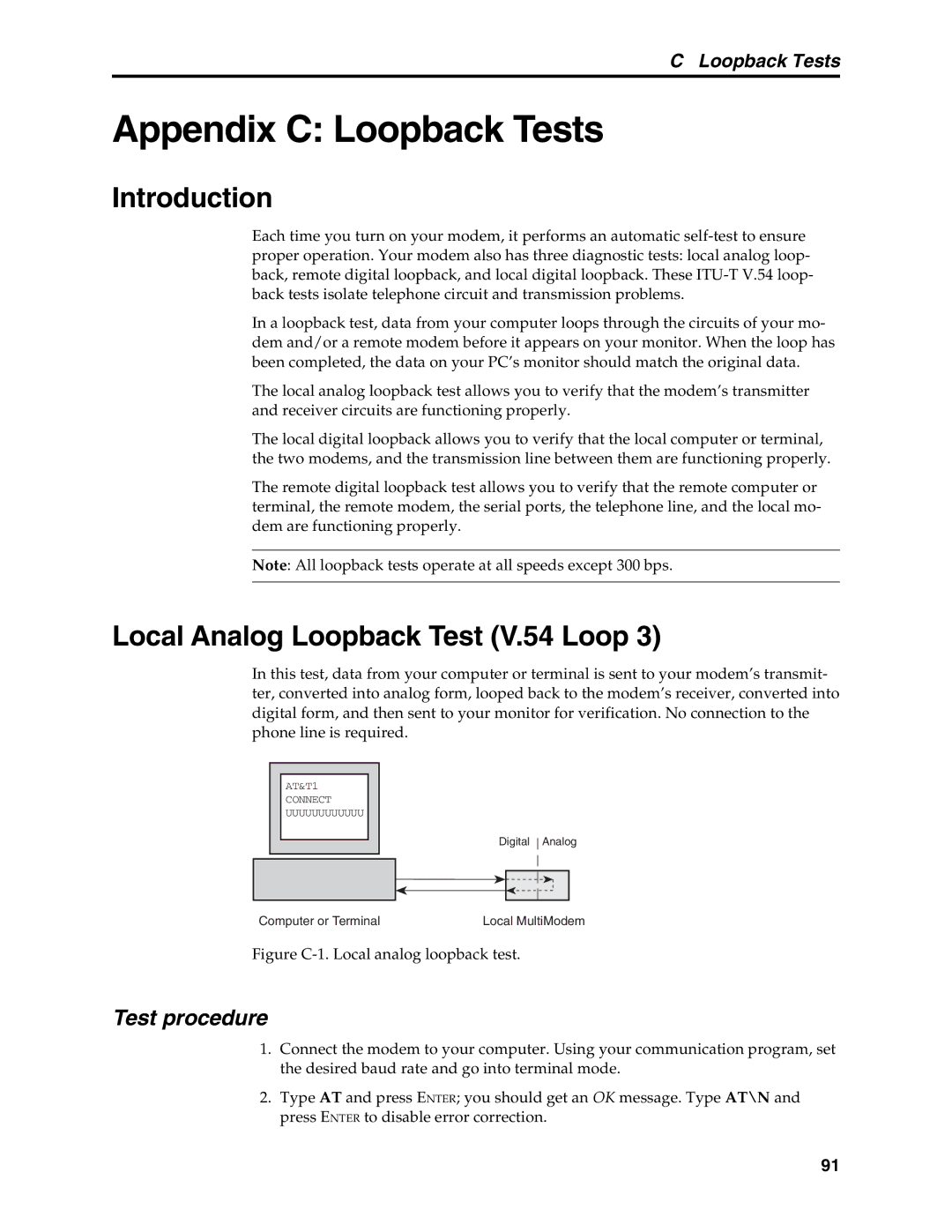Model MT5600BA Model MT5600BL
Record of Revisions
FCC Part
MultiModemII User Guide
Using the Front Panel
Introduction
Quick Start
Callback Security
AT Commands, S-Registers & Result Codes
Remote Configuration
Solving Problems
Appendix E Upgrading the Modem
Appendix D Warranty, Service, and Technical Support
Appendix a Regulatory Compliance
Appendix C Loopback Tests
Contents
Viii
Introduction
Features
Introduction
Product Description
Data
Introduction
Related Manuals
What Is in Your Modem Package?
Quick Start
You supply
Safety Warnings
What You Will Need
We supply
Quick Start
Connect the Modem to Your System
RS232 Connection
Dialup Connection
Power-On Test
Two-Wire Leased Line Connection
Four-Wire Leased Line Connection
Power Connection
Install the Modem in Windows
Adding the Modem to Windows
Removing Your Old Modem from Windows
Install and Configure Your Software
Trio DataComm
Call the Multi-Tech BBS
Windows HyperTerminal
Windows Terminal
Send a Fax
Trio Fax
Microsoft Fax
References
Select Start Programs Accessories Fax Compose new fax
MultiModemII User Guide
Using the Front Panel
LED Indicators
Modem Configuration
Menu Structure
Using the Front Panel
Liquid Crystal Display LCD
Option Selection
MultiModemII User Guide Menu Overview
Using the Front Panel Status Trunk
MultiModemII User Guide Basic Options Trunk
Using the Front Panel Advanced Options Trunk
Diagnostic Options Trunk
MultiModemII User Guide Remote Configuration Options Trunk
Caller ID Options Trunk
Using the Front Panel Phone Number Memory Options Trunk
Status
Menu Options
Using the Front Panel Basic Options
Implemented
Advanced Options
Remote Configuration Options
MultiModemII User Guide Diagnostic Options
Phone Number Memory Options
Caller ID Options
AT Commands Registers Result Codes
Introduction
AT Commands, S-Registers, and Result Codes
AT Commands
Information Request
Echo Command Mode Characters
DS= y Dial Stored Telephone Number
Hook Control
Result Codes Enable/Disable
Monitor Speaker Volume
Monitor Speaker Mode
Return Online to Data Mode
Tone Dialing
Select Register
Set Register Value
Read Register Value
Data Carrier Detect DCD Control
Modem Reset
Result Code Selection
Long Space Disconnect
Modem-Initiated Flow Control
Error Correction Modes
Load Factory Settings
Data Terminal Ready DTR Control
Communications Mode
22bis Guard Tone Control
Flow Control Selection
Data Set Ready DSR Control
Sync/Async Mode
Test Commands
Clear to Send CTS Control
Synchronous Clock Source
Display Current Configuration
Store Current Configuration
Display Last Connection Statistics
Data Compression Control
Select Profile for Hard Reset
Line Signal Level
Zy =x Store Telephone Number
\Bn Transmit Break
Line Signal Quality
PCM Code Selection
\An Maximum MNP Block Size
\Vn Single Line Connect Message
\Nn Error Correction Mode Selection
Reserved,maxTXrateCR
+MS= Modulation Selection
MNP Extended Services
Flash Memory Download
Command -SDR=nDistinctive Ring Control
Command #CBNy=x Store Callback Number
Command #CBPy=x Store Callback Password
Escape Sequence
Command #CID= n Caller ID
Callback Enable/Disable
Command $SBn Serial Port Baud Rate
Registers
Register Unit Range Default Description
S32
S36
S46
Terse Verbose Description
Result Codes
Protocol ALT
+FCERROR
MultiModemII User Guide
Remote Configuration
Basic Procedure
Setup
Changing the Remote Configuration Password
Changing the Remote Escape Character
Remote Configuration
MultiModemII User Guide
Callback Security
Turning Callback Security On and Off
Setup Procedures
Callback Security
Assigning Callback Passwords
Assigning Callback Phone Numbers
Calling Procedure
Callback Security Commands
Command #CBN y= x Store Callback Number
Command #CBPy=x Store Callback Password
Callback Assignments
MultiModemII User Guide
Leased Line Operation
Two-Wire Setup
Leased Line Operation
Four-Wire Setup
Dial Backup and Leased Line Restoral Setup
Dial Backup and Leased Line Restoral
Leased Line Operation
MultiModemII User Guide
Solving Problems
None of the Indicators Light
Solving Problems
Modem Does Not Respond to Commands
Modem Dials But Cannot Connect
Modem4Disconnects While Online
File Transfer4Is Slower Than It Should Be
Modem4Cannot Connect When Answering
Data Is Being Lost
There Are Garbage4 Characters on the Monitor
Modem4Doesn’t Work with Caller ID
Fax and Data4Software Can’t Run at the Same Time
Appendixes
FCC Part 68 Telecom
Appendix a Regulatory Compliance
Regulatory Compliance
Fax Branding Statement
Canadian Limitations Notice
International Modem Restrictions
Commission Decision CTR21
New Zealand Telecom Warning Notice
EMC, Safety, and Terminal Directive Compliance
Appendix B Technical Specifications
Technical Specifications
Receiver Sensitivity
Test procedure
Local Analog Loopback Test V.54 Loop
Loopback Tests
Figure C-2. Remote digital loopback test
Remote Digital Loopback Test V.54 Loop
Figure C-3. Local digital loopback test
Local Digital Loopback Test V.54 Loop
Back-to-Back Test
Figure C-5. Back-to-back test connections
Service
Limited Warranty
Multi-Tech BBS
Online Warranty Registration
Warranty, Service, and Technical Support
Technical Support
About the Internet
SupplyNet Online Ordering Instructions
Ordering Modem Accessories
Identify the Modem Firmware
Upgrade Overview
Upgrading the Modem
Identify the Current Firmware Version
Multi-Tech Web Site
Multi-Tech BBS
Download the Upgrade File
Extract the Upgrade Files
Set the Modem to the Factory Defaults
Restore Your Parameters
Upgrade the Modem’s Firmware
RS-232 Pinouts
Appendix F Cable Pinouts
Cable Pinouts
Leased Line Pinouts
Ctrl Code Hex Dec
Appendix G Ascii Character Map
Index
108
Index
110

